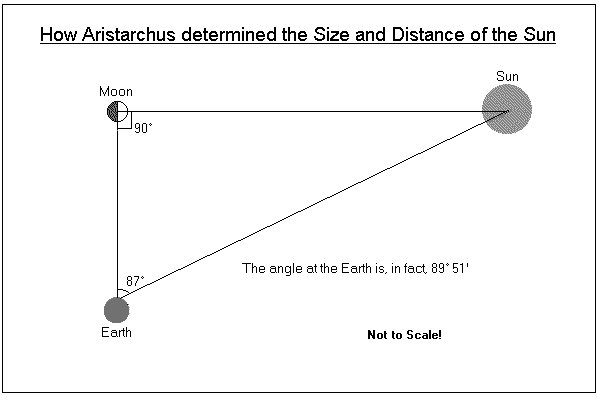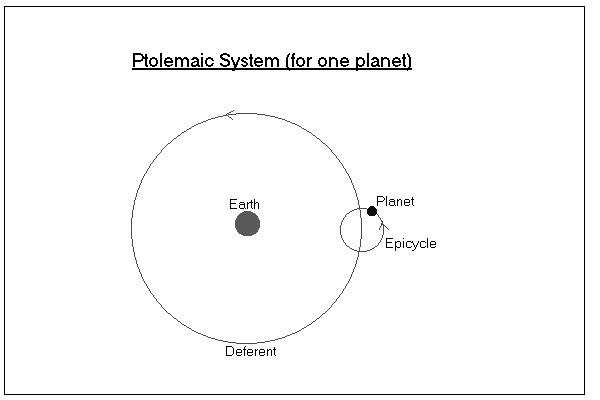This page last modified 1998 July 16
Ancient Greek Astronomy
Making Sense of the Heavens
In our understanding of the heavens, we owe a great deal to those who have gone in the centuries before us.
Stars and Planets
When our ancestors looked at the sky, they saw a dome upon which lights moved. Some of these lights, the stars, remained in the same position in relation to each other.
The stars can be divided into two groups: those which rise and set and those which remain above the horizon whilst they appear to circle a fixed point in the sky, the celestial pole. Our ancestors noticed that this fixed point was higher in the sky rose higher if they travelled northwards, and vice versa. This was seen as evidence that the surface of the Earth is curved.
Stars which appear to be near each other were grouped into constellations — different cultures had different constellations, although there were some similarities. The modern northern constellations are based on the ancient Greek and Roman ones. We now know that the stars of any constellation are not usually related, but that their apparent closeness is a line-of sight effect.
The positions of others, including the brightest ones, changed. These were called "wanderers" (in Greek: "planetos") They were often identified with deities. The seven naked-eye wanderers, or planets, were, in order of speed of apparent movement: Moon, Mercury, Venus, Sun, Mars, Jupiter, Saturn.
The planets' movements are confined to a narrow band of stars a few degrees either side of the path of the Sun, the ecliptic, so called because eclipses can occur when the Moon is on the ecliptic. The constellations of the ecliptic were granted special status as the Zodiac. There are 12, one for each lunation during the course of a year.
Mythology and the Dawn of Astronomy
In order to make sense of the skies, our ancestors created the constellations in the "image" of the deities and heroes of their myths and legends. The planets were ascribed to deities:
| Moon | Selene, Artemis | |
| Mercury | Hermes | |
| Venus | Aphrodite, Ishtar, Inanna, Isis, Hesperos, Lucifer, Phosphoros, Freya | |
| Sun | Phoebus | |
| Mars | Ares | |
| Jupiter | Zeus, Jove | |
| Saturn | Kronos |
The Geocentric Experience
Early astronomy was concerned mainly with prediction for religious and agricultural purposes. Some of the main players in early Greek astronomy were:
Thales of Miletus (624-548 BCE) Measured apparent diameter of Sun accurately. Explained solar eclipses. Defined the constellation Ursa Minor and wrote on its use in navigation.
Pythagoras (572-492 BCE) Earth is Sphere: Ships over horizon, positions of stars and poles change in relation to Earth if move N or S; Elephants. Other celestial bodies also spherical (sphere is perfect). Pythagoras was first to realise the morning and evening stars were the same body (Venus). Discovered that musical harmony could be represented by ratios of integers (whole numbers), which led him to believe that number is the source of all things and that the motion of the planets could be reflected by similar ratios: The Harmony of the Spheres.
Anaxagoras (b. c500 BCE) Moon is earthly in nature, has ravines and plains, shines with a false light. Sun is red-hot stone on fire, larger than Peleponese peninsular. tried for impiety. Death sentence was commuted to exile from Athens (Pericles).
Heracleides of Pontus (b. c388 BCE) "The stars of Hermes and Aphrodite make their retrograde motions and retardations about the rays of the Sun, forming by their courses a wreath or crown with the Sun at its centre." — same model proposed 2000 years later by Tycho Brahe. Earth rotates.
Aristarchus of Samos (310-230 BCE) Worked in Alexandria. Archimedes was his pupil — get most of what we know of him from Archimedes — library of Alexandria burned. What does survive is his On the Sizes and Distances of the Sun and the Moon. When the Moon is at dichotomy (half-phase - 1st or 3rd Quarter), the angle Earth-Moon-Sun is 90°. The angle Moon-Earth-Sun will give the shape of the triangle formed by the three bodies.

Measured angle as 87° — Thales 300yr earlier measured to half deg! Fragments suggest that Aristarchus could do so as well and that he may have thought that the angle was more than 89° 30', but the uncertainties of the precise dichotomy of the Moon and in measurement led him to play safe (remember Anaxagoras!). He suggested Sun 19x further than Moon, 19x as big as Moon. He obtained size and distance of Moon from time it took to pass through Earth's shadow at eclipse. Sun 7x as big as Earth. Eratosthenes (276-196 BCE) had measured Earth to within 50 miles of present value using the altitude of the Sun at midday on same day at Syene (Aswan) and Alexandria.
There were numerous attempts to explain the movements of the planets:
Aristotle (384-322 BCE) had stated that all the bodies of the universe moved on crystal spheres (the perfect shape) with the Sun at the centre. Eudoxus (408-355 BCE) had proposed systems of up to 4 spheres for each planet (27 spheres in all — Aristotle needed 55).
Apollonius of Perga (262-190 BCE) Best known for his work on conics and his primitive form of analytical geometry, which anticipated Descartes by nearly two millennia! He introduced the concepts of eccentric, deferent and epicycle thatwere used extensively by Hipparchus and then Ptolemy.
Hipparchus of Nicaea (190-127 BCE) Made first realistic estimates of distance to Sun and Moon. Calculated year accurate to 6.5minutes. Made a catalogue of stars, which came to mediæval Europe, via Ptolemy and the Moslem Arab astronomers, as Almagest ("The Greatest").
Ptolemy of Alexandria (100-170 CE) refined the system of eccentrics, deferents and epicycles — he used circles instead of spheres. This system lasted for 1500 years.

References
There are a number of excellent books on the mythology and history of astronomy. Among the best of the latter are Sir Thomas Heath's translations of original sources in his Greek Astronomy and his masterly treatment of the subject in Aristarchus of Samos, which contains the full text and drawings of his On the Sizes and Distances of the Sun and the Moon, and also deals with his predecessors. Those of you interested in the relationship between mythology and our understanding of the cosmos will find Anthony Aveni's Conversing With the Planets to be of interest. E.C.Krupp demonstrates his depth of understanding of ancient cultures in his remarkable Skywatchers, Shamans, & Kings, in which he shows how an understanding and interpretation of sky phenomena brought an understanding — and power — to ancient peoples


